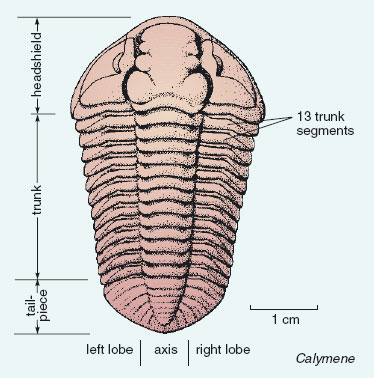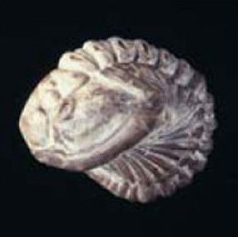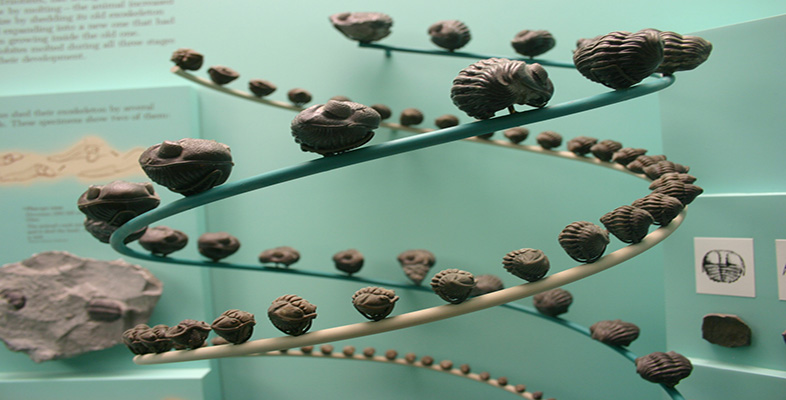4 Life in the Silurian sea
4.1 Trilobites
As we've seen, the Cambrian explosion left the seas teeming with a huge variety of animals. In the following activity you will study some of the marine life at one particular time in the Palaeozoic Era - the middle part of the Silurian Period, 430 Ma ago. You'll look in detail at some fossils which come from a deposit in the UK called the Wenlock Limestone, famous for its many beautiful fossils. The Wenlock Limestone crops out mainly around Birmingham and the borders of Wales.
Figure 4 shows a trilobite from the Wenlock Limestone, called Calymene ('kal-iminny').

Trilobites were a major group of entirely marine arthropods that thrived in the seas of the Palaeozoic Era and eventually became extinct in the Permian Period. The arthopods are an immensely diverse phylum (see Section 1.3). Their external jointed skeleton (exoskeleton) forms a robust armour-plating for the body, though it is flexible at the joints to allow movement.
SAQ 9
Being arthropods, how did trilobites get around the problem of ytheir growth being constrained by an external skeleton?
Answer
Trilobites, like other arthopods, grew by moulting, i.e. periodically casting off their rigid shell, and secreting a new, larger one.
Trilobites are so named because they have three lobes running up and down their length - a central axis, and two lobes: one on either side. They are also divided cross-ways into a headshield, a trunk, and a tailpiece. Have a preliminiary look at the fossil in Figure 4 to see if you can identify these divisions. The trunk has a number of separate segments, and the tailpiece is made of a single plate. The more formal names for the three main divisions of the trilobite body, often used elsewhere, are as follows:
headshield = cephalon; trunk = thorax; tailpiece = pygidium.
Trilobites also had appendages such as antennae and legs, but these are extremely rarely found. An example where legs are preserved is shown on p. 63 of the Atlas.
SAQ 10
What does the rarity of trilobite appendages suggest about their structure?
Answer
They were not so durable, being less mineralised than the components normally found (headshield, trunk and tailpiece), and soon decayed like other soft tissues.
Because trilobites cast off their shell during moulting, most trilobite fossils are actually shed shells, rather than carcasses (dead animals). The trilobite's hard outer shell needed places of weakness along which it could break apart during moulting, a bit like having weak areas between the pieces of a bar of chocolate. There were lines of weakness between the headshield and the front of the trunk; between any two trunk segments; and between the end of the trunk and the front of the tailpiece. Trilobites also had one or more lines of weakness within the headshield. Figure 4 shows these lines of weakness for Calymene; they allowed two side pieces to detach from the larger, central part of the headshield.
Many trilobites had eyes. In Calymene (Figure 4), they are at the cresent-shaped areas on the detachable side pieces either side of the central part of the headshield. The eyes were rather like the compound eyes of a modern fly (another arthropod) in having many lenses. Each trilobite lens was made of calcite, and its preservation potential was as good as the rest of the skeleton (also made mostly of calcite). Trilobites had the earliest recorded eyes in the animal world.
The presence of well-developed eyes suggests that wherever the trilobites were living there was enough light to see by, and, as light fades with depth, the water is unlikely to have been very deep.
It is likely that Calymene spent more time scuttling around on the sea floor than swimming high up in the water. It probably rested on the sea floor, stretched out in the same way as in Figure 4. These trilobites probably ate small organisms and organic debris on or near the sea floor.
Some trilobites could roll up, tucking the tail snugly underneath the head. Figure 5 shows a specimen of Calymene that has rolled itself up into a ball, like a pill bug (a type of woodlouse, another arthropod) can do. The flat, outer edges of the trunk segments had to slide over each other to enable the trilobite to roll up.
SAQ 11
Why might the ability to roll up be useful?
Answer
It would protect any soft parts underneath the hard external skeleton from attack by predators, damage during storms, etc.
By studying fossils one can observe various features of the morphology of an extinct organism, and infer aspects of its mode of life and environment. We can do this by comparing observed features with what is known of living relatives and similar fossils. In practice, when studying fossils one would also take other information into account, such as evidence from the sediment enclosing the fossil, and so on. The result is always an interpretation that reflects the balance of probabilities from the available information, rather than the certain truth.

